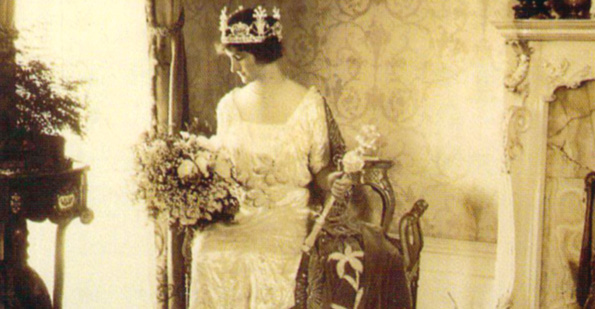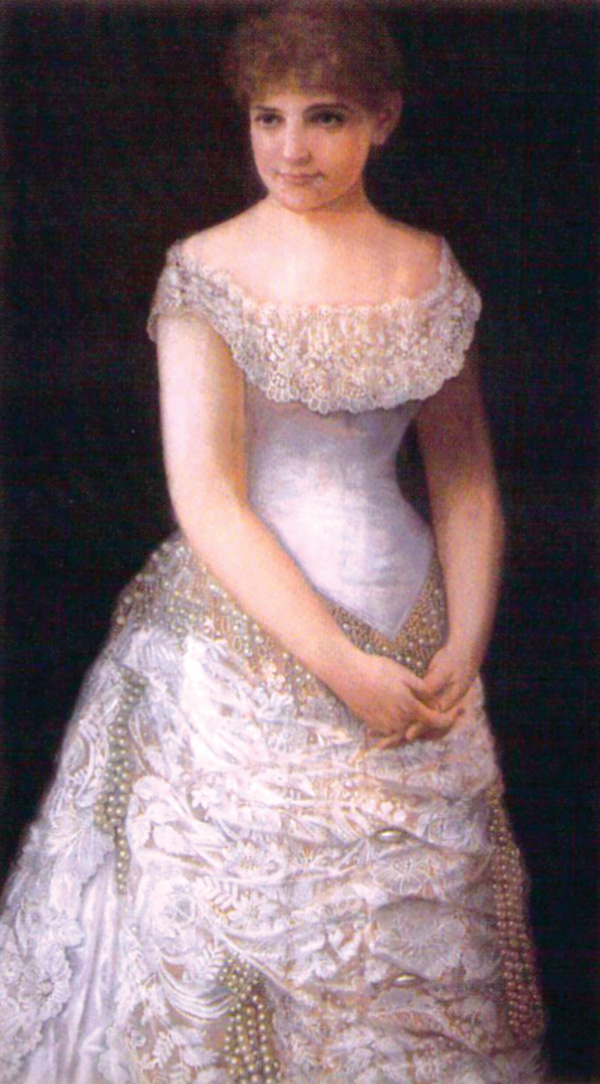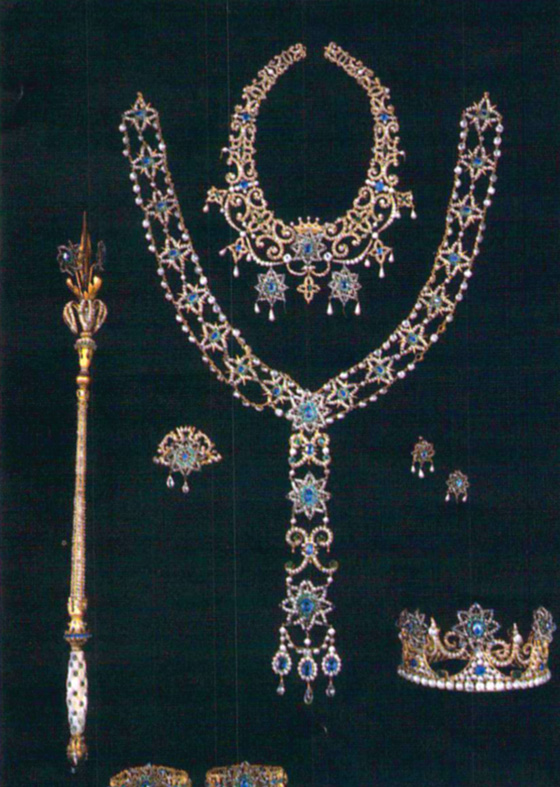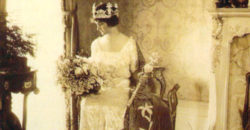Louisiana State Museum
Investments in Royal Vestments
The regalia of New Orleans’s Mardi Gras debutantes is inspired by the monarchs of Europe
Published: February 1, 2016
Last Updated: February 11, 2021

Courtesy of Louisiana State Museum.
Elinor Bright, Queen of Carnival in 1920, shows off the short-lived fashion for Mardi Gras queens' dresses of raised hemlines.

Susie Richardson, who reigned as Queen of Carnival and as Queen of the Krewe of Proteus in 1883, is seen in her elaborate debut gown in this pastel portrait. Louisiana State Museum
The Mistick Krewe of Comus staged the first parade and ball in New Orleans based around a central theme in 1857, and their efforts were hailed as a successful means to organize and clean up what had previously been a raucous “Fat Tuesday” celebration. Other so-called “krewes” sprang up in Comus’s wake, the first being the Twelfth Night Revelers, who began staging their annual Carnival ball on Twelfth Night, or January 6, in 1870. This organization became the first to select a young woman in attendance at the ball to be crowned Queen at their second ball in 1871.
In 1874, the Rex organization, which had been formed two years earlier, began the tradition of crowning a debutante daughter of a krewe member as Queen, a custom that all krewes shortly adopted. While these early queens were crowned spontaneously at the ball, most krewes eventually realized that a young woman and her family must be given ample notice of her selection. Krewes began issuing invitations to lucky young women before the ball to give them time to prepare a wardrobe.
The New Orleans Daily Picayune noted of some of the queens of the 1897 Mardi Gras season:
“[Many] queens have modeled their gowns after the famous queens and empresses whose exquisite taste in dress and design have given their names and that of their reign to numberless glorious [toilettes] which are models of beauty in our own day. ‘A la Marie Stuart,’ ‘a la Marie Antoinette,’ and similar modes are noted designs.”
Even with these influences, debutante queens are usually expected to wear a dress of the latest fashion so that she does not appear as if dressed for a costume ball. Being a Mardi Gras queen is not so much a masquerade as it is assuming a role that requires a certain caliber of attire, namely a custom-made gown appropriately representing the queen’s position and her status as a New Orleans debutante.
In the 19th century, color choice for a queen’s dress was almost always white, representing the debutante’s youth, innocence, purity and unmarried status. Because it is easily soiled, white also communicates the ability of the queen’s family to attire her in a dress that was unlikely to be reworn, very similar to a wedding gown. One must not forget the scandal that Bette Davis caused in the film “Jezebel,” during which she appeared at the fictional Olympus Mardi Gras ball in a red dress. Though she was not depicting a Mardi Gras queen, she was a young unmarried woman and shocked ball guests with her breach of etiquette.
Satin and lace were frequent fabric choices, again representing the glory of the queen’s station and imparting elegance. Satin created an attention-grabbing shimmer under the ballroom lights, and lace exemplified the queen’s status as an arbiter of womanly good taste.
Concurrent with the rise of Carnival krewes in the late 19th century was the appearance of the social column in newspapers, and Mardi Gras queens’ dresses were written about in exacting detail. The queen’s wardrobe served as an example for young women all over New Orleans to which to aspire.

Queen of Proteus in 1912, Corinne McCloskey wears a delicate Medici-style collar with her white lace dress and crown jewels. Louisiana State Museum
Color choices other than white began gaining popularity in the 20th century. Gold and silver emerged as popular choices, deviating from the normal white but still indicating sophistication with their precious metal glimmer reflected by the lights in the ballroom. Cloth of gold and cloth of silver were deemed elegant enough for a Mardi Gras queen and were often much denser and heavier than the earlier choices of white satin and lace, adding weight both symbolically and physically to the queen’s wardrobe.
While the queen’s dress may reflect the newest fashionable styles, the remaining parts of her ensemble, including the crown jewels, the collar and the mantle, are examples taken straight from European royalty of centuries ago. Perhaps no other accessory like the crown jewels embodies the queen’s royal status. A Mardi Gras queen looks every bit the royal when she dons a metal and stone crown that she balances precariously on her head.
Early crown jewels were imported from Parisian jewelers, most of whom sadly remain anonymous to us today. So valued were these baubles, made only of gilt metal and glass stones, that many were displayed in windows of jewelry stores in New Orleans for weeks before the queen even got to wear them.
One of the more unusual parts of a queen’s parure was the girdle. Not the Lycra number that 20th-century women became familiar with, the girdle was an unusual jeweled contraption that encircled a queen’s waist and dripped with dangling baubles in front. The girdle was likely the distant cousin of the jeweled belt that women wore as far back as the Middle Ages. These early belts not only offered cinching and support; they also created a surface from which to suspend small accessories, making it an ancestor also of the Victorian chatelaine.
Aristocratic women of the Elizabethan era, including Elizabeth I herself, were frequently depicted in portraits attired in jeweled belts that served only to accentuate the silhouette and draw the eye down to the hem of the dress. By that time, the jeweled girdle served no utilitarian purpose, as rigid stays under the dress provided the necessary constriction of the torso.
In more recent times, Queen Alexandra, wife of King Edward VII of Great Britain, wore a jeweled girdle at her coronation in 1902 when her husband gained the throne after the death of his mother, Queen Victoria, the year before. Jeweled girdles were fashionable among Mardi Gras queens only for as long as their waistlines were impossibly small and clearly defined by the contours of their dresses and, invariably, the corsets worn underneath. When the waistline disappeared in the 1920s, so did the girdle.

As Queen of Carnival in 1901, Bessie Merrick wore this complete parure, including crown, scepter, necklace, girdle, earrings, bracelets and brooch marked with the year of her reign. Louisiana State Museum
Perhaps no other garment offers as great a test to a queen’s poise as the mantle. The mantle of a Mardi Gras queen is the long flat textile that attaches either at the back of the neck or the back of the waist and trails behind her as she walks across the ballroom floor. The mantle reflects the sumptuary laws of the Middle Ages, which regulated the length of a woman’s dress according to her rank. Longer trains indicated a higher social ranking, explaining why the longest trains, which eventually became completely detached mantles, were reserved for royalty.
The length of a queen’s mantle today averages about 15 feet, although longer lengths have been seen. One newspaper account of a Mardi Gras ball in the 1920s put the length of the queen’s mantle at 24 feet, although this may be a bit of an exaggeration. For comparison, the train on Princess Diana’s wedding dress in 1981 was 25 feet. European royals have long worn mantles as a symbol of their sovereignty, and Queen Elizabeth will still sport a mantle today at such events as the annual opening of Parliament.
What may be seen as the most archaic bit of a Mardi Gras queen’s wardrobe is the collar. What has come to be called the Medici collar began as a stiff lace panel worn in an upright position behind the head by women in the ruling class Medici family in Europe in the late sixteenth century, especially Marie de Medici, wife of the first Bourbon king of France, Henry IV, and mother of future King Louis XIII. Women in the Elizabethan court and in courts of other countries also favored the Medici-style collar. The Medici collar itself was likely a variation on the ruff, the full-round pleated linen or lace collar that surrounded the neck. The Medici-style collar was open in front and must certainly have been less stifling than the ruff.
The high-standing Medici collar was devised as a flattering frame for the wearer’s head, and as such, it lived on through the centuries in a variety of forms. Variations can be seen throughout the 18th and 19th centuries. Empress Josephine, wife of Napoleon Bonaparte, made popular the unusual shoulder panels seen in many of her portraits. These were likely inspired by the Medici collar. By the 1880s, women’s coats and capes were sporting upright collars.
While our Mardi Gras queens do not rule over an authentic kingdom, they, with the help of their regal ensembles, do embody the spirit of the true queen: graceful, indefatigable and fearless.
—–
A. Wayne Phillips, Curator of Costumes and Textiles; Louisiana State Museum

